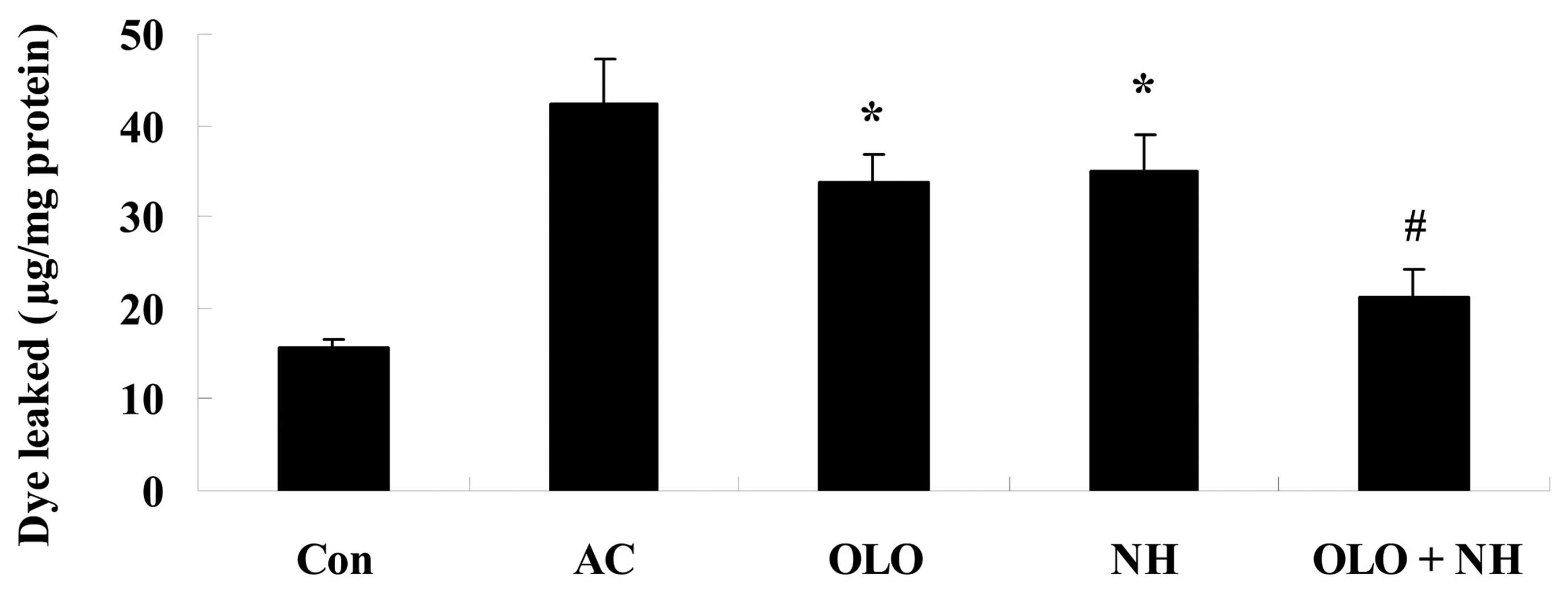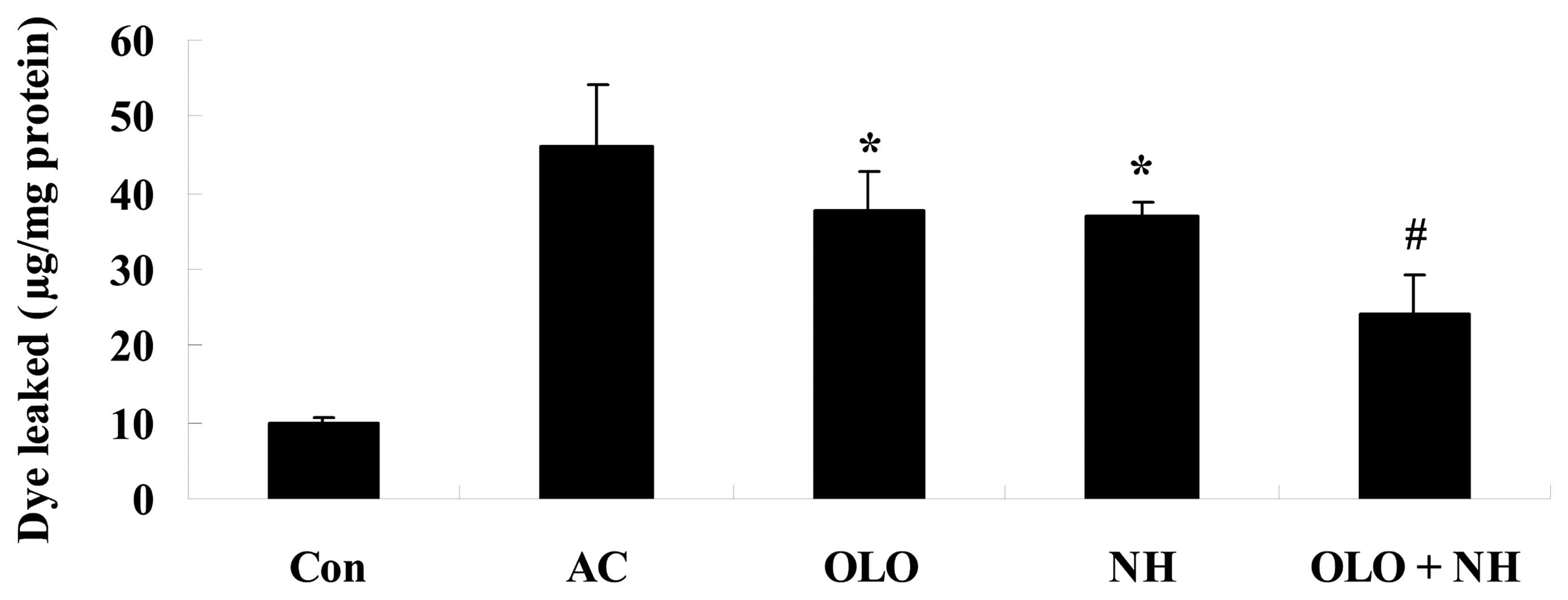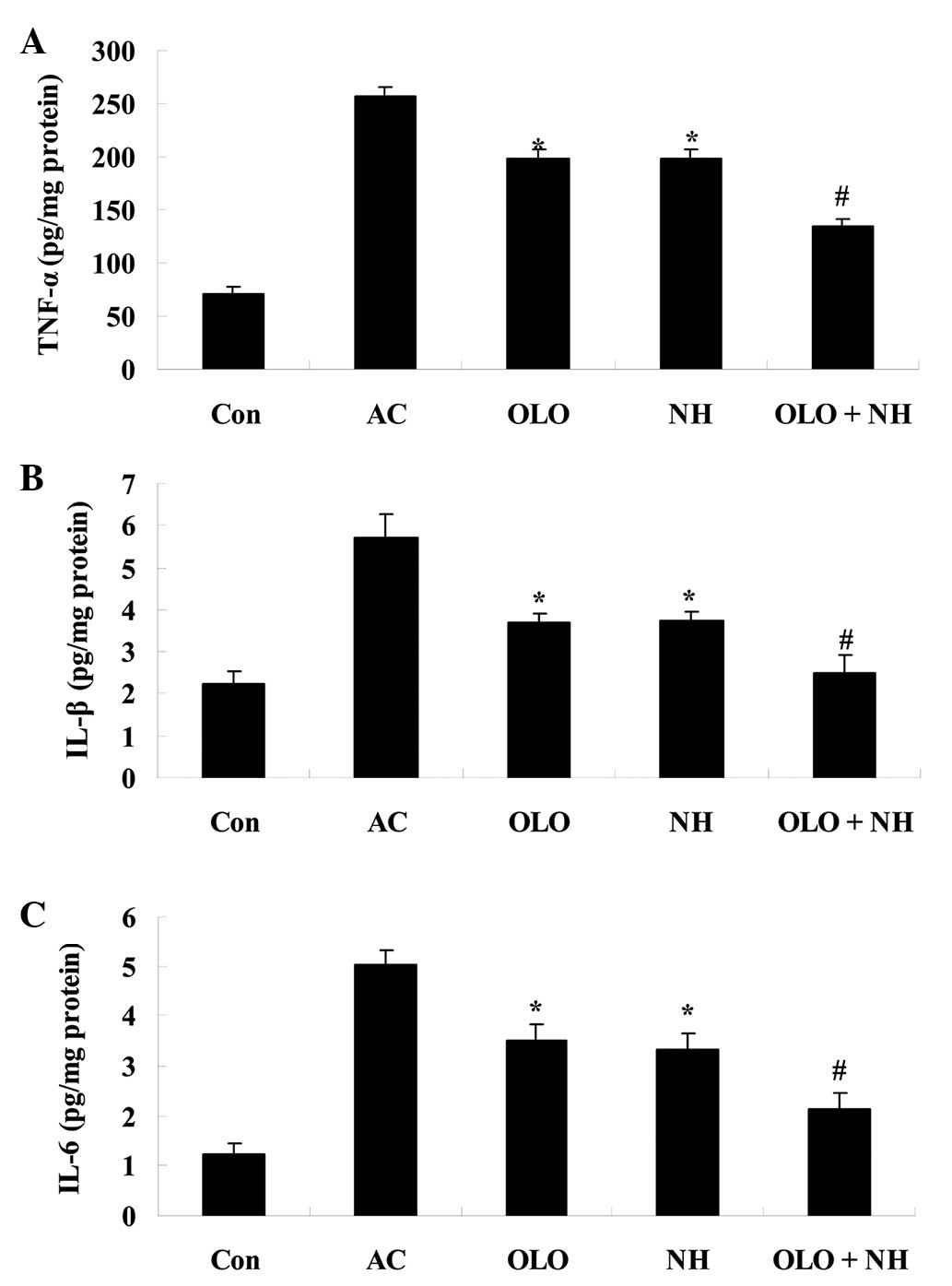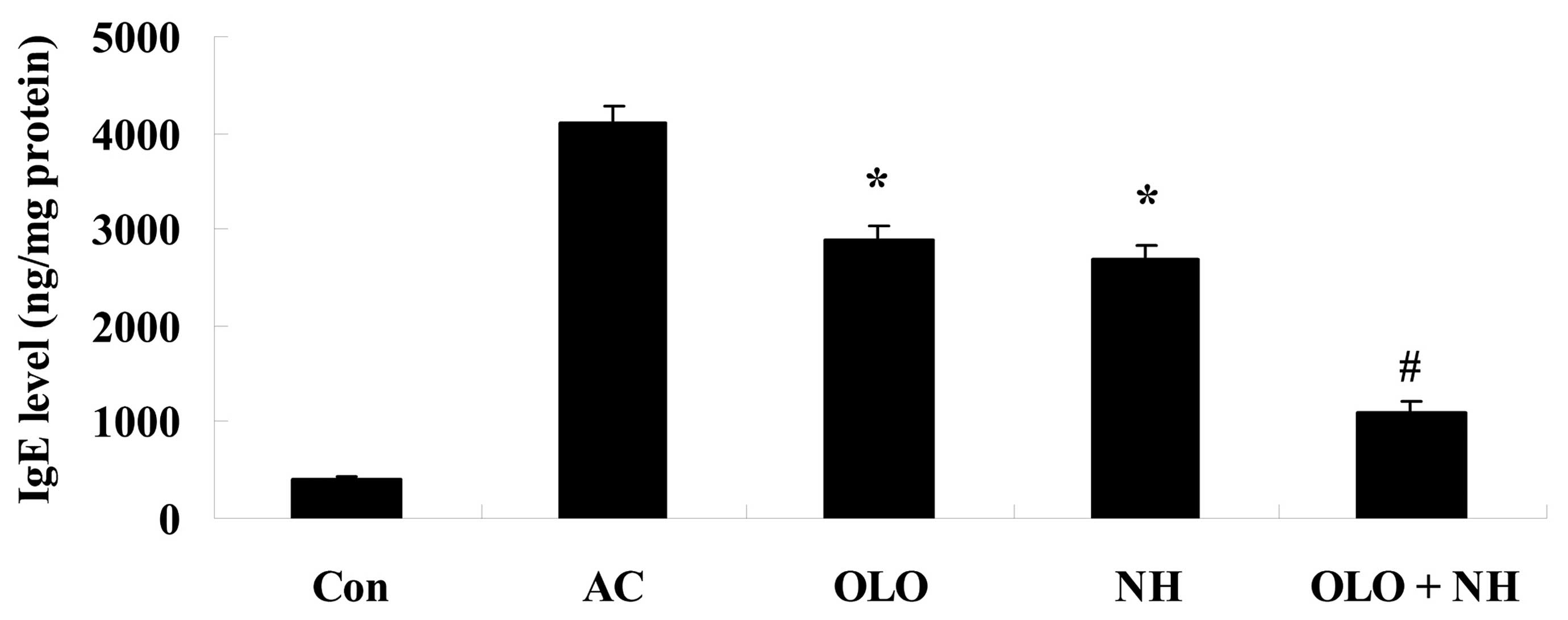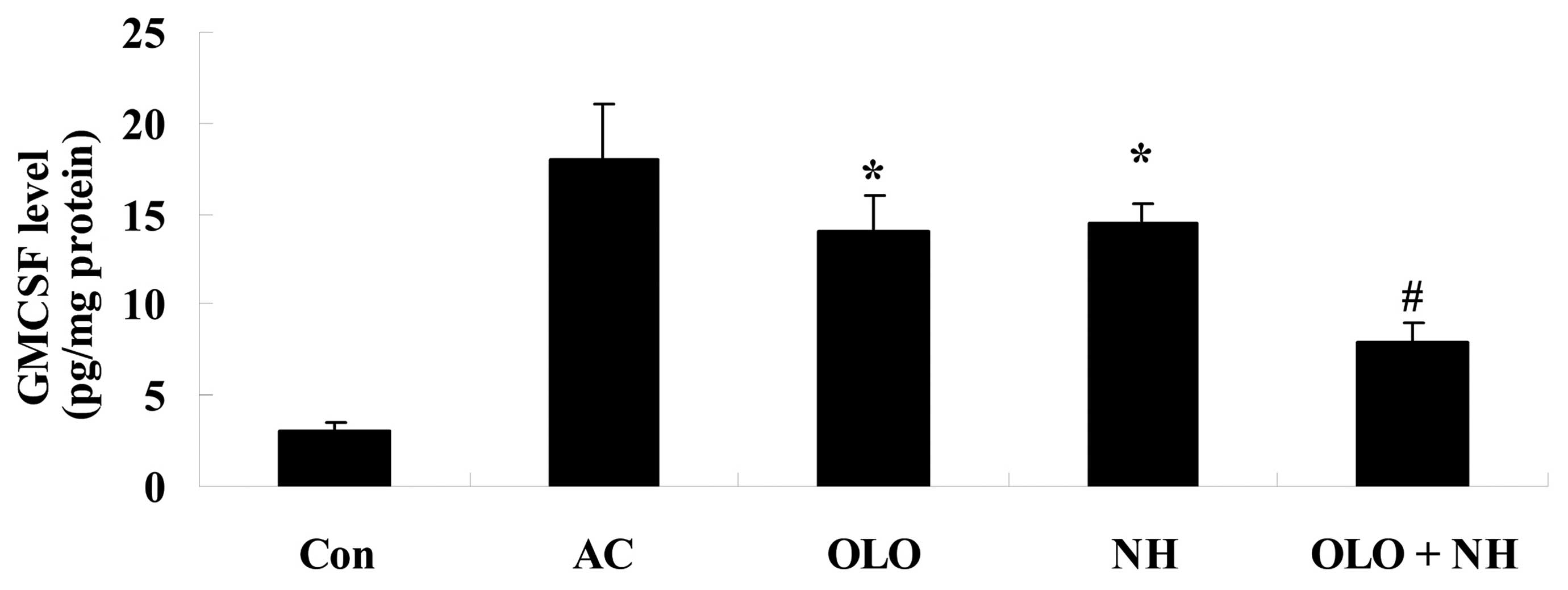|
1
|
Fujishima H, Ohashi Y and Takamura E:
Efficacy of epinastine hydrochloride ophthalmic solution in
allergic conjunctivitis by conjunctival cedar pollen allergen
challenge. Ann Allergy Asthma Immunol. 113:476–481. 2014.
View Article : Google Scholar : PubMed/NCBI
|
|
2
|
Irkec MT and Bozkurt B: Molecular
immunology of allergic conjunctivitis. Curr Opin Allergy Clin
Immunol. 12:534–539. 2012. View Article : Google Scholar : PubMed/NCBI
|
|
3
|
Williams JI, Kennedy KS, Gow JA,
Torkildsen GL, Abelson MB, Gomes PJ and McNamara TR; Bepotastine
Besilate Ophthalmic Solutions Study Group: Prolonged effectiveness
of bepotastine besilate ophthalmic solution for the treatment of
ocular symptoms of allergic conjunctivitis. J Ocul Pharmacol Ther.
27:385–393. 2011. View Article : Google Scholar : PubMed/NCBI
|
|
4
|
Sgrulletta R and Bonini S, Lambiase A and
Bonini S: Allergy and infections: Long-term improvement of vernal
keratoconjunctivitis following viral conjunctivitis. Eur J
Ophthalmol. 16:470–473. 2006.PubMed/NCBI
|
|
5
|
Chen H, Yang HW, Wei JF and Tao AL: In
silico prediction of the T-cell and IgE-binding epitopes of Per a 6
and Bla g 6 allergens in cockroaches. Mol Med Rep. 10:2130–2136.
2014.PubMed/NCBI
|
|
6
|
Lopes-Ferreira M, Gomes EM, Bruni FM,
Ferreira MJ, Charvet P and Lima C: First report of interruption of
mast cell degranulation and endothelial cells activation by
anti-inflammatory drugs controlling the acute response provoked by
Pseudoplatystoma fasciatum fish venom. Toxicon. 90:237–248. 2014.
View Article : Google Scholar : PubMed/NCBI
|
|
7
|
Lam DS, Fan DS, Ng JS, Yu CB, Wong CY and
Cheung AY: Ocular hypertensive and anti-inflammatory responses to
different dosages of topical dexamethasone in children: A
randomized trial. Clin Experiment Ophthalmol. 33:252–258. 2005.
View Article : Google Scholar : PubMed/NCBI
|
|
8
|
Kase S, Yokoi M, Ishida S and Kase M:
Measurement of interleukins in vitreous infusion fluid. Biomed Rep.
3:818–820. 2015.PubMed/NCBI
|
|
9
|
Waisbourd M, Levinger E, Varssano D,
Moisseiev E, Zayit-Soudri S, Barak A, Loewenstein A and Barequet I:
High-dose topical bevacizumab for corneal neovascularization.
Pharmacology. 92:310–314. 2013. View Article : Google Scholar : PubMed/NCBI
|
|
10
|
Pemberton JD, MacIntosh PW, Zeglam A and
Fay A: Naphazoline as a confounder in the diagnosis of carotid
artery dissection. Ophthal Plast Reconstr Surg. 31:e33–35. 2015.
View Article : Google Scholar
|
|
11
|
Greiner JV and Udell IJ: A comparison of
the clinical efficacy of pheniramine maleate/naphazoline
hydrochloride ophthalmic solution and olopatadine hydrochloride
ophthalmic solution in the conjunctival allergen challenge model.
Clin Ther. 27:568–577. 2005. View Article : Google Scholar : PubMed/NCBI
|
|
12
|
McLaurin EB, Marsico NP, Ackerman SL,
Ciolino JB, Williams JM, Villanueva L and Hollander DA: Ocular itch
relief with alcaftadine 0.25% versus olopatadine 0.2% in allergic
conjunctivitis: Pooled analysis of two multicenter randomized
clinical trials. Adv Ther. 31:1059–1071. 2014. View Article : Google Scholar : PubMed/NCBI
|
|
13
|
Tamura T: Olopatadine ophthalmic solution
suppresses substance P release in the conjunctivitis models. Asia
Pac Allergy. 2:115–121. 2012. View Article : Google Scholar : PubMed/NCBI
|
|
14
|
Souri E, Amanlou M, Farsam H and Afshari
A: A rapid derivative spectrophotometric method for simultaneous
determination of naphazoline and antazoline in eye drops. Chem
Pharm Bull (Tokyo). 54:119–122. 2006. View Article : Google Scholar
|
|
15
|
Berger WE, Ratner PH, Casale TB, Meltzer
EO and Wall GM: Safety and efficacy of olopatadine hydrochloride
nasal spray 0.6% in pediatric subjects with allergic rhinitis.
Allergy Asthma Proc. 30:612–623. 2009. View Article : Google Scholar : PubMed/NCBI
|
|
16
|
Curran JP, Nunez JR and Visconti E:
Primary meningococcal conjunctivitis. N Y State J Med. 89:634–635.
1989.PubMed/NCBI
|
|
17
|
Joob B and Wiwanitkit V: Rasanjana Madhu
Ashchyotana for a mucopurulent conjunctivitis. Ayu. 33:1462012.
View Article : Google Scholar : PubMed/NCBI
|
|
18
|
Kuo PC, Lin JY, Chen LC, Fang YT, Cheng
YC, Wu HY, Tsai CY, Chen YS, Lin SY, Wu CL and Ling QD: Molecular
and immunocytochemical identification of coxsackievirus A-24
variant from the acute haemorrhagic conjunctivitis outbreak in
Taiwan in 2007. Eye (Lond). 24:131–136. 2010. View Article : Google Scholar
|
|
19
|
Rank RG, Bowlin AK, Tormanen KI, Wang Y
and Maurelli AT: Effect of inflammatory response on in vivo
competition between two chlamydial variants in the guinea pig model
of inclusion conjunctivitis. Infect Immun. 80:612–619. 2012.
View Article : Google Scholar :
|
|
20
|
Fernandez-Robredo P, Recalde S,
Moreno-Orduña M, García-García L, Zarranz-Ventura J and
García-Layana A: Azithromycin reduces inflammation in a rat model
of acute conjunctivitis. Mol Vis. 19:153–165. 2013.PubMed/NCBI
|
|
21
|
Li Y, Zhang Z, Zhao J, Li H, Ren K and
Xing R: Influences of Bushen Xingnao Decoction on expression of
vascular endothelial growth factor, IL-1β and tumor necrosis
factor-α in vascular dementia rats. Pak J Pharm Sci. 28:2317–2320.
2015.PubMed/NCBI
|
|
22
|
Borkenstein A, Faschinger C, Maier R,
Weger M, Theisl A, Demel U, Graninger W, Irene H and Mossböck G:
Measurement of tumor necrosis factor-alpha, interleukin-6, Fas
ligand, interleukin-1α, and interleukin-1β in the aqueous humor of
patients with open angle glaucoma using multiplex bead analysis.
Mol Vis. 19:2306–2311. 2013.
|
|
23
|
Cavone L, Muzzi M, Mencucci R, Sparatore
B, Pedrazzi M, Moroni F and Chiarugi A: 18β-glycyrrhetic acid
inhibits immune activation triggered by HMGB1, a pro-inflammatory
protein found in the tear fluid during conjunctivitis and
blepharitis. Ocul Immunol Inflamm. 19:180–185. 2011. View Article : Google Scholar : PubMed/NCBI
|
|
24
|
Murota H, El-latif MA, Tamura T, Amano T
and Katayama I: Olopatadine hydrochloride improves dermatitis score
and inhibits scratch behavior in NC/Nga mice. Int Arch Allergy
Immunol. 153:121–132. 2010. View Article : Google Scholar : PubMed/NCBI
|
|
25
|
Tamura T, Matsubara M, Amano T and Chida
M: Olopatadine ameliorates rat experimental cutaneous inflammation
by improving skin barrier function. Pharmacology. 81:118–126. 2008.
View Article : Google Scholar
|
|
26
|
Liu L, Rich BE, Inobe J, Chen W and Weiner
HL: Induction of Th2 cell differentiation in the primary immune
response: Dendritic cells isolated from adherent cell culture
treated with IL-10 prime naive CD4+ T cells to secrete
IL-4. Int Immunol. 10:1017–1026. 1998. View Article : Google Scholar : PubMed/NCBI
|
|
27
|
Chen H, Luo Z, Shen H, Ren C, Li Z, Tang
J, Wang J and Wu T: Research on the roles of transcription factors
T-bet and GATA-3 in aplastic anemia. Clin Lab. 60:291–295.
2014.PubMed/NCBI
|
|
28
|
Krzyzowska M, Polanczyk M, Bas M, Cymerys
J, Schollenberger A, Chiodi F and Niemialtowski M: Mousepox
conjunctivitis: The role of Fas/FasL-mediated apoptosis of
epithelial cells in virus dissemination. J Gen Virol. 86:2007–2018.
2005. View Article : Google Scholar : PubMed/NCBI
|
|
29
|
Mello CB, Ramos L, Gimenes AD, Andrade TR,
Oliani SM and Gil CD: Immunomodulatory effects of galectin-1 on an
IgE-mediated allergic conjunctivitis model. Invest Ophthalmol Vis
Sci. 56:693–704. 2015. View Article : Google Scholar : PubMed/NCBI
|
|
30
|
Wang Z and Davies JD: CD8 blockade
promotes the expansion of antigen-specific CD4+
FOXP3+ regulatory T cells in vivo. Int Immunopharmacol.
7:249–265. 2007. View Article : Google Scholar :
|
|
31
|
Eperon S, Berguiga M, Ballabeni P,
Guex-Crosier C and Guex-Crosier Y: Total IgE and eotaxin (CCL11)
contents in tears of patients suffering from seasonal allergic
conjunctivitis. Graefes Arch Clin Exp Ophthalmol. 252:1359–1367.
2014. View Article : Google Scholar : PubMed/NCBI
|
|
32
|
Acar N, Toker E and Kazokoglu H: Tear and
serum eosinophil cationic protein levels in seasonal allergic
conjunctivitis. Eur J Ophthalmol. 13:671–675. 2003.PubMed/NCBI
|
|
33
|
Mimura T, Amano S, Funatsu H, Yamagami S,
Araie M, Kaji Y, Arimoto A, Ishida Y, Usui T and Okamoto S:
Correlations between allergen-specific IgE serum levels in patients
with allergic conjunctivitis in spring. Ocul Immunol Inflamm.
12:45–51. 2004. View Article : Google Scholar : PubMed/NCBI
|
|
34
|
Cook EB, Stahl JL, Barney NP and Graziano
FM: Olopatadine inhibits TNFalpha release from human conjunctival
mast cells. Ann Allergy Asthma Immunol. 84:504–508. 2000.
View Article : Google Scholar : PubMed/NCBI
|
|
35
|
Zhou W, Chu D, Sha W, Fu L and Li Y:
Effects of granulocyte-macrophage colony-stimulating factor
supplementation in culture medium on embryo quality and pregnancy
outcome of women aged over 35 years. J Assist Reprod Genet. Dec
10–2015.Epub ahead of print.
|
|
36
|
Son BK, Sawaki D, Tomida S, Fujita D,
Aizawa K, Aoki H, Akishita M, Manabe I, Komuro I, Friedman SL, et
al: Granulocyte macrophage colony-stimulating factor is required
for aortic dissection/intramural haematoma. Nat Commun. 6:69942015.
View Article : Google Scholar : PubMed/NCBI
|
|
37
|
Huang G, Sun T, Zhang L, Wu Q, Zhang K,
Tian Q and Huo R: Combined application of alginate dressing and
human granulocyte-macrophage colony stimulating factor promotes
healing in refractory chronic skin ulcers. Exp Ther Med.
7:1772–1776. 2014.PubMed/NCBI
|
|
38
|
Min L, Isa SA, Fam WN, Sze SK, Beretta O,
Mortellaro A and Ruedl C: Synergism between curdlan and GM-CSF
confers a strong inflammatory signature to dendritic cells. J
Immunol. 188:1789–1798. 2012. View Article : Google Scholar : PubMed/NCBI
|
|
39
|
Tamura T, Matsubara M, Hasegawa K, Ohmori
K and Karasawa A: Olopatadine hydrochloride suppresses the rebound
phenomenon after discontinuation of treatment with a topical
steroid in mice with chronic contact hypersensitivity. Clin Exp
Allergy. 35:97–103. 2005. View Article : Google Scholar : PubMed/NCBI
|
|
40
|
Priyanka HP, Sharma U, Gopinath S, Sharma
V, Hima L and ThyagaRajan S: Menstrual cycle and reproductive aging
alters immune reactivity, NGF expression, antioxidant enzyme
activities, and intracellular signaling pathways in the peripheral
blood mononuclear cells of healthy women. Brain Behav Immun.
32:131–143. 2013. View Article : Google Scholar : PubMed/NCBI
|
|
41
|
Hu CP, Wu XR, Li QG, Sun ZW, Wang AP, Feng
JT and Wang J: Proteomic analysis of NGF-induced
transdifferentiation of adrenal medullary cells. Int J Mol Med.
32:347–354. 2013.PubMed/NCBI
|
|
42
|
Mita S, Shimizu Y, Sato A, Notsu T, Imada
K and Kyo S: Dienogest inhibits nerve growth factor expression
induced by tumor necrosis factor-α or interleukin-1β. Fertil
Steril. 101:595–601. 2014. View Article : Google Scholar
|
|
43
|
Taishi P, Churchill L, De A, Obal F Jr and
Krueger JM: Cytokine mRNA induction by interleukin-1beta or tumor
necrosis factor alpha in vitro and in vivo. Brain Res. 1226:89–98.
2008. View Article : Google Scholar : PubMed/NCBI
|
|
44
|
Antonelli A, Lapucci G, Vigneti E, Bonini
S and Aloe L: Human lung fibroblast response to NGF, IL-1beta, and
dexamethsone. Lung. 183:337–351. 2005. View Article : Google Scholar
|
|
45
|
Gruber HE, Hoelscher GL, Bethea S and
Hanley EN Jr: Interleukin 1-beta upregulates brain-derived
neurotrophic factor, neurotrophin 3 and neuropilin 2 gene
expression and NGF production in annulus cells. Biotech Histochem.
87:506–511. 2012. View Article : Google Scholar : PubMed/NCBI
|
|
46
|
Vieira KP, de Almeida e Silva Lima Zollner
AR, Malaguti C, Vilella CA and de Lima Zollner R: Ganglioside GM1
effects on the expression of nerve growth factor (NGF), Trk-A
receptor, proinflammatory cytokines and on autoimmune diabetes
onset in non-obese diabetic (NOD) mice. Cytokine. 42:92–104. 2008.
View Article : Google Scholar : PubMed/NCBI
|
|
47
|
Ryan VH, German AJ, Wood IS, Hunter L,
Morris P and Trayhurn P: NGF gene expression and secretion by
canine adipocytes in primary culture: upregulation by the
inflammatory mediators LPS and TNFalpha. Horm Metab Res.
40:861–868. 2008. View Article : Google Scholar : PubMed/NCBI
|
|
48
|
Tamura T and Kimoto N: Efficacy of
repeated pretreatment with olopatadine hydrochloride on rhinitis
induced by intranasal instillation of toluene-2,4-diisocyanate in
rats. Pharmacology. 84:288–293. 2009. View Article : Google Scholar : PubMed/NCBI
|
|
49
|
Yang WJ, Yang YN, Cao J, Man ZH, Li Y and
Xing YQ: Paxillin regulates vascular endothelial growth factor
A-induced in vitro angiogenesis of human umbilical vein endothelial
cells. Mol Med Rep. 11:1784–1792. 2015.
|
|
50
|
Ferrara N and Henzel WJ: Pituitary
follicular cells secrete a novel heparin-binding growth factor
specific for vascular endothelial cells. Biochem Biophys Res
Commun. 161:851–858. 1989. View Article : Google Scholar : PubMed/NCBI
|
|
51
|
Xu JY, Meng QH, Chong Y, Jiao Y, Zhao L,
Rosen EM and Fan S: Sanguinarine is a novel VEGF inhibitor involved
in the suppression of angiogenesis and cell migration. Mol Clin
Oncol. 1:331–336. 2013.
|
|
52
|
Sahin E, Baycu C, Koparal AT, Burukoglu
Donmez D and Bektur E: Resveratrol reduces IL-6 and VEGF secretion
from co-cultured A549 lung cancer cells and adipose-derived
mesenchymal stem cells. Tumour Biol. Dec 18–2015.Epub ahead of
print. View Article : Google Scholar : PubMed/NCBI
|
|
53
|
Bills VL, Salmon AH, Harper SJ, Overton
TG, Neal CR, Jeffery B, Soothill PW and Bates DO: Impaired vascular
permeability regulation caused by the VEGF(1)(6)(5)b splice variant
in pre-eclampsia. BJOG. 118:1253–1261. 2011. View Article : Google Scholar : PubMed/NCBI
|
|
54
|
Okabe K, Kobayashi S, Yamada T, Kurihara
T, Tai-Nagara I, Miyamoto T, Mukouyama YS, Sato TN, Suda T, Ema M
and Kubota Y: Neurons limit angiogenesis by titrating VEGF in
retina. Cell. 159:584–596. 2014. View Article : Google Scholar : PubMed/NCBI
|
|
55
|
Tamura T: Investigation of the
antiallergic activity of olopatadine on rhinitis induced by
intranasal instillation of antigen in sensitized rats using
thermography. Asia Pac Allergy. 1:138–144. 2011. View Article : Google Scholar : PubMed/NCBI
|















